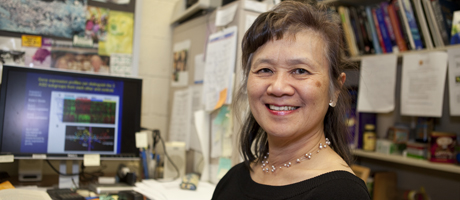By Danny Freedman
A new study by GW researchers may bring a cheek-swab test for autism closer to reality.
In the study, published last week in the online journal PLoS One, researchers identified a set of tiny inconsistencies in DNA that were associated with common autistic behaviors. The team then found those DNA anomalies to be significantly involved among people with autism.
Lead author Valerie Hu, a professor in GW’s Department of Biochemistry and Molecular Biology, said these pieces of DNA could provide previously elusive biological hallmarks for use in screening DNA for autism.
Such a diagnostic test could identify a person’s risk of developing autism, she said, but also point to specific types of autism, as categorized by behavioral traits such as autism featuring severe language deficits or savant qualities.
Screening that could be applied even to newborns would be a considerable advance, since one of the most widely accepted autism treatments—behavioral intervention—hinges on early detection. Currently autism is diagnosed based observation of abnormal behavioral development over a child’s first few years.
(On Friday, Dr. Hu will be giving a seminar covering these findings and her last study, concerning a gene that may help explain why autism affects males more often than females. The lecture will be from 12 p.m. to 1 p.m. in Ross Hall room 224.)
The new study builds on previous work by Dr. Hu, which found that autistic individuals could be fairly neatly divided into four behavioral subtypes—those with severe language deficits, milder symptoms across the board, savant qualities, and intermediate severity—based on scores from a common diagnostic questionnaire.
Then looking at gene activity, or expression, from people in three of those groups, Dr. Hu showed that each group had a largely distinct “signature” of gene expression that differentiated it from the other groups as well as non-autistic individuals.
The same divide-and-conquer technique was used in the new PLoS One study by Dr. Hu and her collaborators: Anjene Addington, of the National Institute of Mental Health, and Alexander Hyman, a high school student who interned in Dr. Hu’s lab last summer, when the research was conducted.
The researchers first identified small differences in the building blocks of DNA, called nucleotides, that could be associated with any of several common autistic behaviors.
The arrangement of the body’s four different nucleotides, over and over in various combinations, creates the genetic blueprint for each person and is largely the same across all humans. But where the sequences are slightly jumbled—a relatively common occurrence, called single nucleotide polymorphisms, or SNPs (pronounced “snips”)—is where the researchers looked for links to autistic traits.
Sifting through more than half a million SNPs, the team initially identified 167 that were associated with the autistic traits they were looking for.
The researchers then divided nearly 3,000 autistic individuals into the four behavioral subgroups to look for those SNPs and found 18 SNPs that each were “highly significant” to at least one subgroup.
The location of those SNPs in the DNA led the researchers to speculate that most of the 18 SNPs are involved in regulating the activity of genes, and that the genes were related to neurological functions and disorders that already are associated with autism.
Ten of the SNPs were relevant to more than one of the autism subgroups, but often in a lopsided way—causing one group to have a higher risk of developing the particular trait associated with the SNP than another group. That finding, Dr. Hu said “reinforces the idea that these subtypes are genetically different,” and that it therefore makes sense to divide and study the groups separately.
Dr. Hu said the approach so far to so-called genome-wide association studies of autism mostly has been to study increasingly larger populations separated into just two groups: individuals with autism and those without. But the stark heterogeneity of the autistic population—the vast differences that exist from case to case—has been a stumbling block for these types of studies, she said.
“The real power comes in the subdividing,” Dr. Hu said. “When you create more homogenous subsets”—that is, when cases that are more similar are grouped together—“you get more power to identify differences between cases and controls.”
Dr. Hu said her team is pursuing larger-scale studies that would need to be done to validate the findings before the work could be translated into a diagnostic test.


